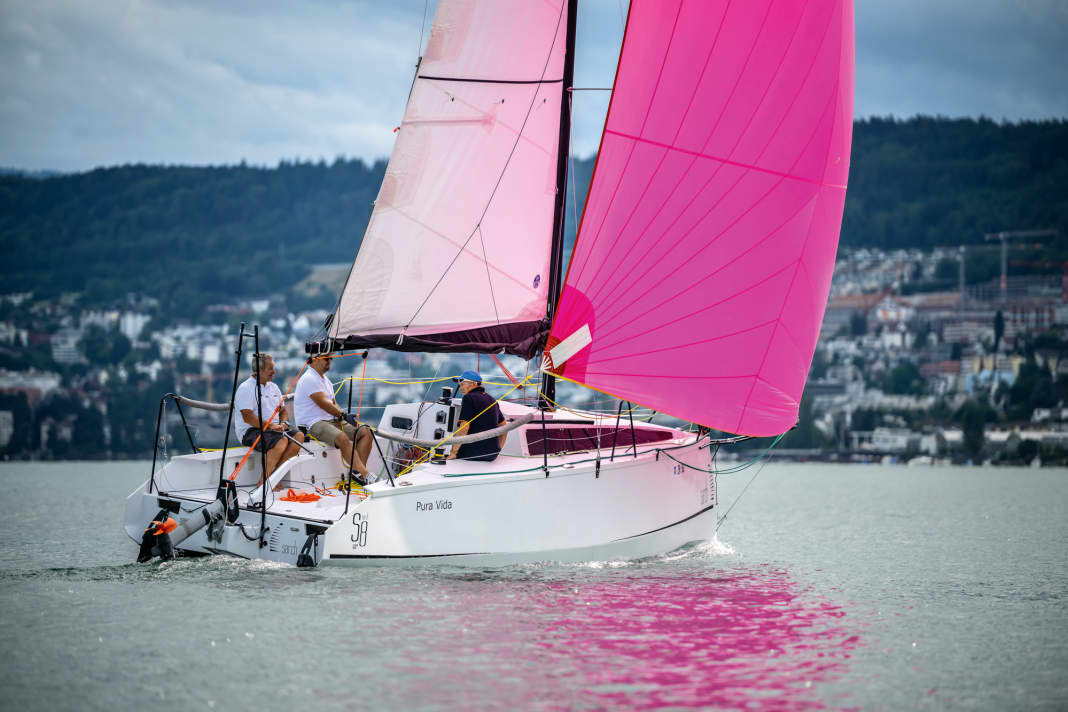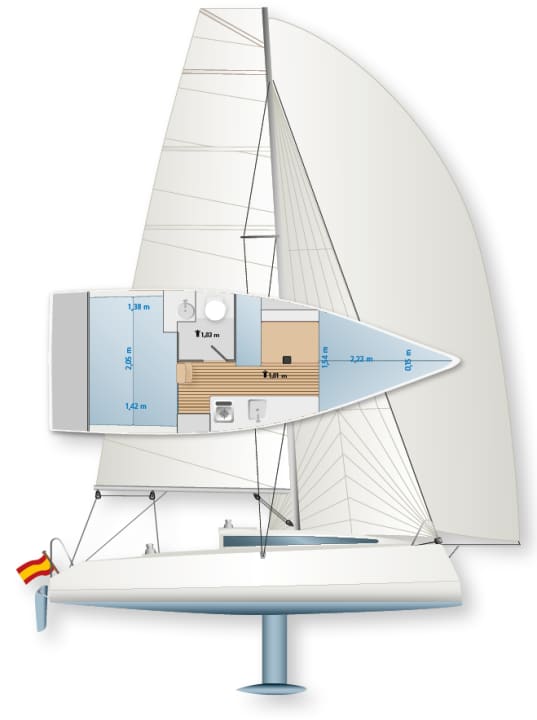





Small boats are popular, and not just because they are inexpensive and easy to handle. Small and compact cruisers also make a significant contribution to the boat market as a welcome basis for beginners and as an uncomplicated platform for a multi-faceted leisure and sports community. However, the market segment is unfortunately no longer being served with new entries to the same extent as it was ten years ago and before. In particular, the often very inexpensive and therefore attractive offers from Polish manufacturers have largely disappeared. The general price explosion within the industry is taking its toll even here. It is well known that it is difficult to earn money with the serial production of small boats.
However, this also opens up opportunities and possibilities for new, young manufacturers who want to fill the gaps with exciting and individualised products in small series. Brands such as Sarch (pronounced "Sartsch"). The shipyard in the small Spanish town of Pego, not far from Valencia, entered the market in 2017 with the very unusual Sarch S7 small cruiser project. YACHT has the Test of the unconventional boat 2019 was published. This was followed by the small sports boat dS6, which initially extended the line downwards ( Test YACHT 6/2020 ), now back on top with the larger Sarch S8 compact cruiser. And the plan is to continue in the same vein: An S10 is being planned and will probably go into production soon.
The competition: handy, affordable, suitable for touring and already seaworthy
Construction number three of the new S8 is available to us for a test sail in Switzerland. Lake Zurich, not known as a particularly wind-safe spot, once again lives up to its reputation. For the time being, there is not even a breeze. Time to get to grips with the design and construction of the Spaniard.
Sarch builds the hulls of its boats from plywood in a multi-buckling frame. The structures are then covered with carbon fibre on the outside and glass fibre on the inside and the entire construction is laminated and compacted with resin infusion under vacuum. The construction method is not only unusual, but also unique and promises particularly rigid structures with low weight. The deck is a conventional GRP sandwich construction with a foam core, also built using the vacuum infusion process.
Sarch: striking and extraordinary
Axel de la Hidalga is the man who, alongside shipyard boss Paco Pons, is responsible for the production of the boats at Sarch Composites. And he is also responsible for their design, which is just as unusual as the construction method. The hull of the multi-buckling frame has an almost square frame. The freeboard drops vertically over the entire length of the ship and down to the waterline. There, the hull lines bend hard, almost at right angles to an extremely flat underwater area. Viewed from the front, the hull is almost cube-shaped.
Another striking feature is the kink in the bow stem, which has become a kind of trademark for Sarch boats. The shape has little significance in terms of design, but can visually loosen up the otherwise chunky hull lines. The cabin superstructure, which extends almost to the outside of the hull in a wedge shape, also contributes to the rather corpulent appearance, similar to a classic forecastle.
Although the S8 is one metre longer than its little sister S7, it has essentially the same design, the same concept, the same layout on deck and an almost identical interior. In addition, both boats are the same width, namely 2.49 metres, and are therefore also suitable for easy transport on a road trailer. On the other hand, the shipyard is flexible and offers the option of fitting a swivelling keel or, as on the test boat, a lifting keel, which is raised on deck with the help of the winch and a tackle hoist. This worked perfectly in the test. However, when raised, the lifting keel bounces wildly back and forth in the keel box. The shipyard therefore wants to adjust the guides again.
Sailing challenges for helmsman and crew
Together with the double rudder blades, which are attached to the stern and can also be raised, the Sarch S8 can be easily launched and retrieved via the slip ramp. Its low weight also makes it easy to transport on the trailer. Ready to sail, the Sarch S8 weighs just 1.2 tonnes with a ballast content of 27 percent. This makes it significantly lighter than comparable boats from the competition.
Would the low weight also prove to be an advantage when sailing? To find out, Lake Zurich now offers a light wind of around six knots (2 Beaufort), which is just about enough to get an impression of the sailing characteristics. What is noticeable is the initially very high dimensional stability of the full hull with its sharp and low-lying chine edges. However, the construction is only really stiff up to a certain lean angle; with more pressure under gennaker, the boat quickly takes on a lot of heel. This places demands on the helmsman and crew, who have to react quickly to prevent the boat from suddenly going off course, which can happen quickly.
The Sarch S8 is therefore a boat that wants to be sailed very actively and even offers a certain sportiness with its agile, lively sailing characteristics. Its low weight is also noticeable with surprisingly good acceleration. As an additional booster, the comparatively high and powerful sail plan with a square top mainsail and a short overlapping genoa ensures good performance, as does the relatively slim T-keel with a draught of up to two metres and a lead bomb. The S8 can reach a speed of around 4.4 knots at just under two wind forces, with a turning angle of around 90 degrees.
Sarch S8 still has room for improvement
Nevertheless, it is not easy for the helmsman and he needs strength to master the steering. This is because the tiller is clearly too short without necessity and therefore conveys little steering feel. There is also a lot of play in the steering system itself and in the guides of the rudder blades, which is unpleasant. The Spaniards want to work on this and optimise the mechanics.
And there is even more potential for improvement. The relatively high railing supports as well as the bow and stern pulpit are only bolted to the deck on very small base plates. They are extremely weak, offer no safety as a means of holding on and therefore do not fulfil their purpose. The shipyard also needs to work on the sliding hatch above the sideways offset companionway. The guides are too loose and the cover cannot be locked in place. Because there is no running deck on the side of the quasi-back deck, it is essential to walk forwards over the superstructure and thus over the sliding hatch. If you are not careful, you can easily fall here.
The aluminium mast comes from the manufacturer AG+ and is on deck. An optional mast-laying device with a folding mast base and a jib boom is available. The device is easy to operate, even single-handedly. The bowsprit is a special feature. The trunk can be folded up for manoeuvring in the harbour, for transport and for easy attachment of a gennaker or Code Zero by folding the water stay - a good idea.
Unrivalled space below deck on the Sarch S8
Below deck, the Sarch S8 surprises with an unexpected amount of space. And with a headroom of over 1.80 metres in the middle of the saloon, which is very unusual for boats of this size. In keeping with the general character of the Sarch, the layout of the interior fittings is anything but conventional. The galley is built into the side of the saloon as one long row with large work surfaces and lots of storage space, which is usually only the case on boats of 40 feet in length or more. Instead, the seating area is reduced to a small, roughly square saloon table. Two or a maximum of three people can sit at it, but no more. Instead, there is a spacious and completely separate toilet area, even with a shower option. This is also a unique selling point within the eight metre hull length class.
Two adults sleep very comfortably and with plenty of space in the open forward cabin or in the double berth installed aft under the cockpit floor. In addition, the small saloon table can be lowered and the area can also be used as a berth, for example for a child. All in all, the extension below deck and the layout are very exciting because they are rare and different. And the interior is also very bright, friendly and inviting thanks to the flat superstructure windows and a large deck hatch. I like that.
However, the finishing quality still leaves a lot to be desired in some areas. Some of the surfaces are unattractively finished and there are sometimes large gaps between the components. And there is also a lot of potential for improvement in the details when installing the technical on-board installations.
The appeal of the Sarch S8 lies in its extravagant concept, far removed from the mainstream. Despite its peculiarity, the boat from Spain works quite well and even better if the shipyard can iron out the remaining flaws. And the price is also right, considering the good basic equipment and the elaborate construction.
The measured values for testing the Sarch S8



Technical data Sarch S8

- Design engineer:Axel de la Hidalga
- CE design category:B
- Torso length:7,95 m
- Total length:9,20 m
- Waterline length:7,95 m
- Width:2,49 m
- Draught (lifting keel):0,50-2,00 m
- Mast height above WL:12,50 m
- Theor. torso speed:6.8 kn
- Weight:1,2 t
- Ballast/proportion:0,32 t/27 %
- Mainsail:24,3 m²
- Furling genoa (106 %):16,4 m²
- Gennaker:60,0 m²
- Machine (outboard motor):8 PS
- Batteries:12 V/90 Ah
- Fresh water tank (bag):80 l
Hull and deck construction
Hull built from plywood in a buckling frame with carbon fibre reinforcements (outside) and glass fibre (inside). Deck GRP sandwich construction with PVC foam core, manufactured by vacuum infusion. The keel is made of aluminium, the ballast bomb of lead
Rig and sail
The aluminium mast comes from the manufacturer AG+ in France. The rig is on deck and can optionally be folded using a mast-laying device. A single set of Dacron sails (main and furling genoa) is included as standard ex shipyard
Motorisation
Outboard petrol or electric, built-in diesel or pod electric motor. Numerous motorisation options are available. All variants are only available as an option
Equipment and prices
- Base price ex shipyard: 118.900 €
- Price ready to sail: 124.820 €
- General guarantee:2 years
As of 9/2023, how the prices shown are defined can be found here !
Shipyard and distribution
Sarch Composites SL; 03780 Pego (Spain); www.sarch.es
YACHT review of the Sarch S8
Compact cruiser from Spain with an extravagant design and an unusual concept. The boat is also very special visually. Moderately priced
Design and concept
- + Polyvalent alignment
- + Elaborate, robust construction
- - Looks take some getting used to
Sailing performance and trim
- + Lively sailing characteristics
- + One-handed suitability
- - Curious heeling behaviour
Living and finishing quality
- + Bright and cosy inside
- + Large, separate wet room
- - Unattractive features of the extension
Equipment and technology
- + Good basic equipment
- + Lifting and swivelling keel possible
- - Tiller clearly too short

